Explore India’s vibrant display of nature’s beauty with these top Flowering Trees in India or Ornamental trees in India.
India, a land of diverse flora and fauna, is home to a remarkable variety of flowering trees. These majestic trees not only enhance the aesthetic appeal of the landscape but also contribute to the ecological balance. In this article, we will explore the list of flower trees for home along with their pictures, highlighting their distinct features, blooming seasons, and significance.
List of Flowering Trees | Ornamental trees in india
| S. No. | Common name- Ornamental trees in india | Scientific name – Flowering tree |
| 01 | Gulmohar | Delonix regia |
| 02 | Palash | Butea monosperma |
| 03 | Jacaranda | Jacaranda mimosifolia |
| 04 | Indian Laburnum | Cassia fistula |
| 05 | Indian Bael | Aegle marmelos |
| 06 | Indian Coral Tree | Erythrina variegata |
| 07 | Ashoka Tree | Saraca asoca |
| 08 | Pride of Burma | Amherstia nobilis |
| 09 | Indian Cork Tree | Millingtonia hortensis |
| 10 | Pride of India | Lagerstroemia speciosa |
| 11 | Yellow silk cotton tree | Cochlospermum religiosum |
| 12 | Copper Pod | Peltophorum pterocarpum |
| 13 | Parijat | Nyctanthes arbor-tristis |
| 14 | Silk Cotton Tree | Bombax ceiba |
| 15 | Indian Beech Tree | Pongamia pinnata |
| 16 | Devil’s Tree | Alstonia scholaris |
| 17 | Orchid tree/ Kachnar | Bauhinia purpurea |
| 18 | Indian Almond | Terminalia catappa |
| 19 | Bottlebrush Tree | Callistemon citrinus |
| 20 | Crepe Jasmine | Tabernaemontana divaricata |
| 21 | Java Cassia | Cassia javanica |
| 22 | Ruffled fan palm | Licuala grandis |
| 23 | Rain Tree | Albizia saman |
Read More:
- Top Low Light Hanging Plants to make your Room Crunchy
- 365 days Flowering Plants in India | All Season Flowering Plants in India
Flowering Trees in India | Ornamental trees in india
Gulmohar (Delonix regia) – Flowers tree
Oh! Well! Let’s start with my favourite. A sight to behold is the Gulmohar tree’s brilliant reddish-orange blossoms. It originated in Madagascar and has come to represent Indian summers. We can consider that Gulmohar is the best ornamental trees in India, due to its evergreen, quick growing nature and widespread canopy, thus suitable for use as shade giving and specimen tree.
Gulmohar grows to a height of 10 to 20 metres. During the months of April and June, Gulmohar trees bloom, illuminating the gardens and streets with their vivid hues. The Gulmohar Tree’s buttressed trunk, vibrant and vivid blossoms are its most alluring characteristic making contrast with dark green fine textured foliage. Large, beautiful flowers grow on trees that are normally blazing red, orange, or occasionally a combination of both colours. Four elongated petals and a fifth, slightly smaller petal at the centre give the blooms their distinctive shape. The Gulmohar Tree is a magnificent sight when it is fully bloomed; it resembles a dazzling flame and draws everyone’s attention.

Palash (Butea monosperma)
The Palash tree, scientifically known as Butea monosperma, is a beautiful and culturally significant tree that is native to the Indian subcontinent. Also known as the Flame of the Forest, Bastard Teak, or Dhak, it is revered for its vibrant and fiery red-orange flowers that bloom in abundance during April to May. The tree height varies from 5 to 10 metres and posses coarse textured leaves.
The most captivating feature of the Palash tree is its stunning flowers that resembles parrot’s beak. Although Palash is a deciduous, slow growing tree, it withstands frost, drought and salinity. The tree produces striking, flame-shaped flowers that are bright red to orange in color, resembling flames flickering in the forest. These flowers tree typically bloom in dense clusters and cover the tree, creating a mesmerizing and breathtaking sight. The flowers can be used as a source of natural colours used as dyes.

Jacaranda (Jacaranda mimosifolia)
The Jacaranda tree, or Jacaranda mimosifolia as it is known technically, is a magnificent and well-known tree prized for its gorgeous display of purple-blue flowers. It is a South American native that has been extensively cultivated throughout the world for its decorative value and striking beauty. It is a deciduous tree reaching a height of 8 to 9 metres with a wide canopy.
The abundance of trumpet-shaped blossoms on the jacaranda tree is its most alluring feature. The tree blooms in clusters of vivid purple-blue flowers in late spring or early summer (March to may), covering the entire tree in a stunning display of colour. The flowers are so numerous that they frequently cover the tree’s fine textured leaves, giving the impression that the tree is covered in a purple blooming canopy. Topping the branches once in three years may result in attractive bushy canopy.
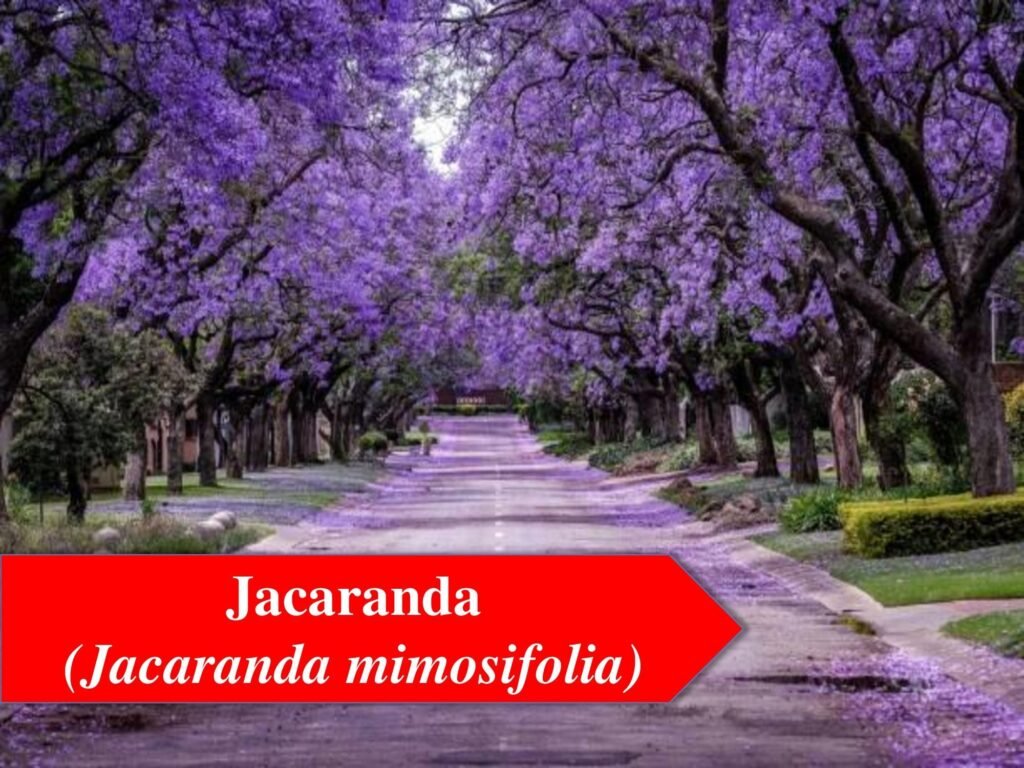
Indian Laburnum (Cassia fistula)
The Indian Laburnum, scientifically known as Cassia fistula, is a striking and culturally significant tree that is native to South Asia. It is a slow growing, medium sized tree growing upto 10 metres, thus suitable for planting under electrical lines. Also known as the Golden Shower Tree or Amaltas, it is revered for its stunning display of golden-yellow flowers that cascade from its branches. This creates a breathtaking spectacle during the flowering season (April to May).
The most captivating feature of the Indian Laburnum is its profusion of pendulous, trumpet-shaped flowers. In the spring season, the tree produces large clusters of golden-yellow blossoms that hang gracefully from its branches, resembling a cascading shower of golden rain. The flowers are not only visually stunning but also emit a subtle and pleasant fragrance that attracts various pollinators, including bees and butterflies. It is suitable for growing in dried tracts of India.
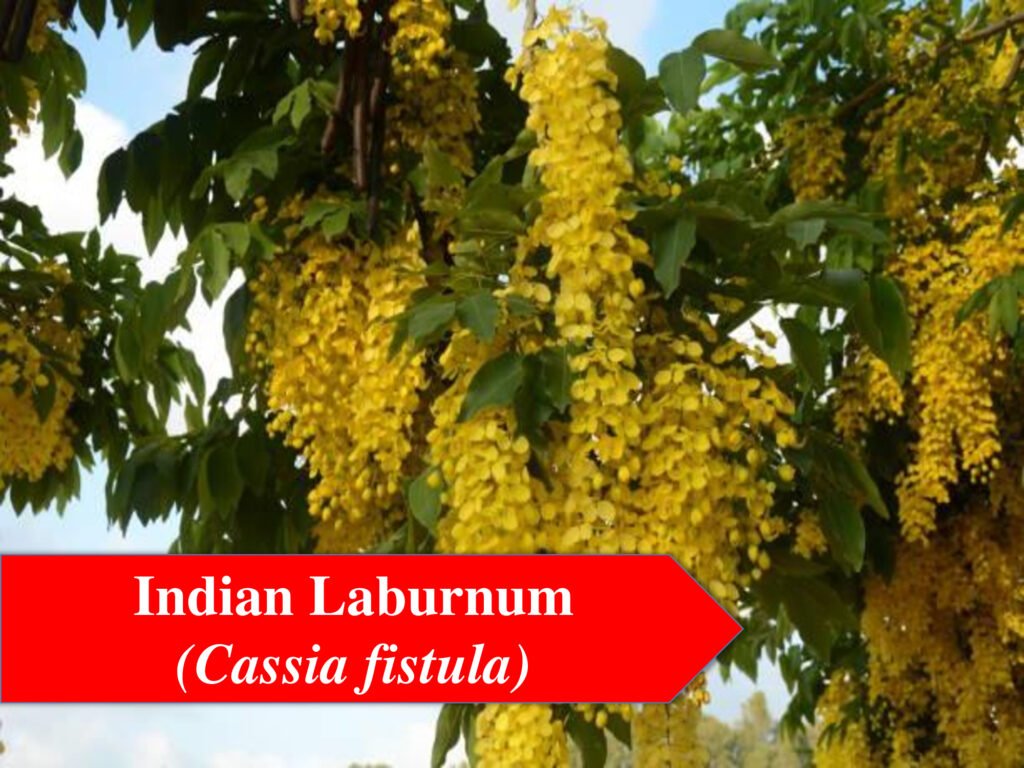
Indian Coral Tree (Erythrina variegata)
The Indian Coral Tree, scientifically known as Erythrina variegata, is a stunning and eye-catching tree native to South Asia and various tropical regions. It is a fast-growing, small tree growing upto 10 to 12 metres height. Also known as the Tiger’s Claw or Indian Coral wood, it is celebrated for its striking appearance and vibrant red-orange flowers that bloom in dense clusters.
The most captivating feature of the Indian Coral Tree is its brilliant red-orange flowers. During the flowering season, which typically occurs in spring (February to April), the tree produces dense, cylindrical clusters of blossoms that resemble coral in their appearance. The flowers have a distinct claw-like shape, which gives rise to one of its common names, Tiger’s Claw. When in full bloom, the Indian Coral Tree becomes a focal point in any landscape, attracting admiration and awe from all who see it. It is well suited for avenue plantations.
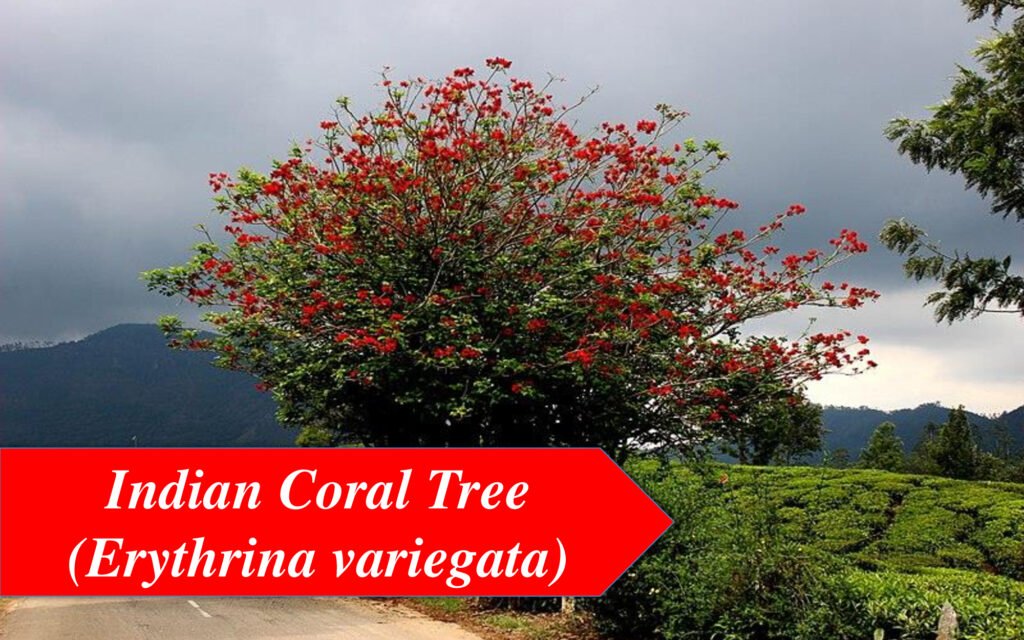
Ashoka Tree (Saraca asoca)
The Ashoka tree, scientifically known as Saraca asoca or Saraca indica, is a revered and symbolic tree in South Asia, particularly in India, where it holds significant cultural and religious importance. Also known as the Sorrowless Tree or the Ashoka Sundari, it is celebrated for its graceful appearance, fragrant flowers, and association with various legends and historical events.
One of the most notable features of the Ashoka tree includes its small stature (7 to 10 metres height), attractive branching pattern forming a crown shape, evergreen foliage that are red when young and the beautiful flowers. During the flowering season, which typically occurs in February to May, the tree produces abundant clusters of small, fragrant, and delicate flowers. The blossoms are various shades of orange, yellow, or pale pink, and they create a breathtaking sight, adorning the tree with colorful beauty. This tree can be easily propagated through seeds.
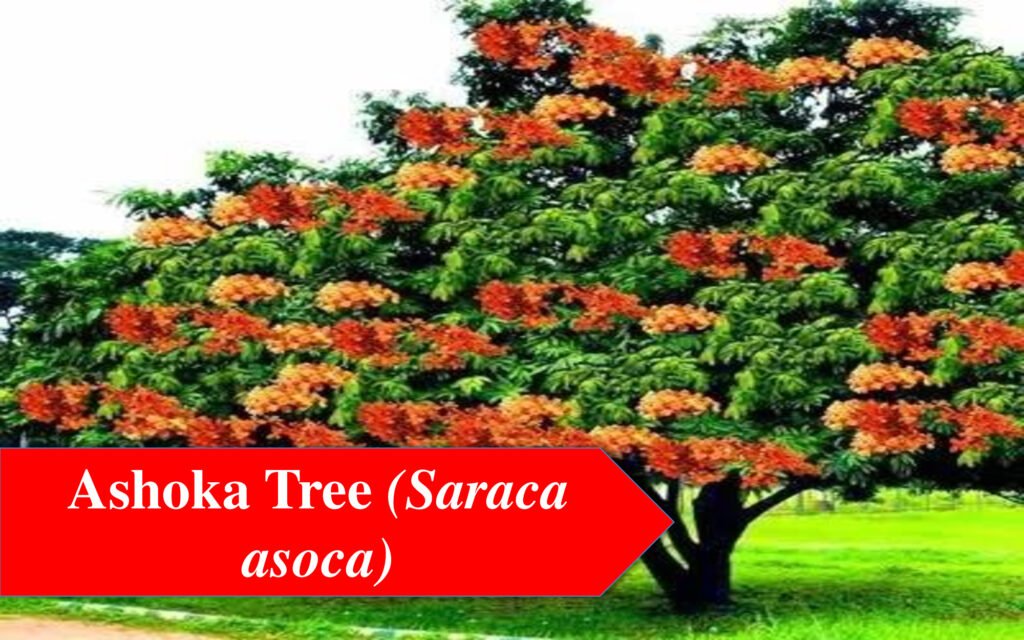
Read More:
- Types of Money Plant for Wealth and Good Vibes
- Summer Flowering Plants in India: 10 Outstanding Blooms
Pride of Burma (Amherstia nobilis)
Pride of Burma, scientifically known as Amherstia nobilis, is a rare and captivating flowering tree that is native to Southeast Asia. Also known as the Tree of heaven or the Queen of Flowering Trees, it is revered for its stunning and cascading clusters of bright red or crimson flowers, which dangle gracefully from its branches like exquisite pendant ornaments. It is an evergreen, medium-sized tree reaching to a height of 8 to 10 metres, which makes it the best suitable trees for home garden in the rainy regions of India.
The most captivating feature of the Amherstia tree is its newly emerging leaves, attaining various shades upon maturation and stunning flowers. The young leaves assume various shades of pink, copper, mauve or purple and on maturation, turns into bright shining green colour. During the flowering season, which typically occurs in late spring or early summer that falls on February to April, the tree produces long, pendulous racemes of bright red or crimson blossoms. Each flower has five petals, with the uppermost one forming a large and showy banner, while the other four petals hang down, resembling delicate and strikingly beautiful cascades.

Indian Cork Tree (Millingtonia hortensis)
The Indian Cork Tree, scientifically known as Millingtonia hortensis, is a charming and enchanting tree that is native to South Asia, particularly India. Also known as the Tree Jasmine or Akash Neem, it is celebrated for its delicate and sweetly scented white flowers that adorn the tree, filling the air with a pleasant fragrance. Millingtonia is a quick growing, evergreen tree, reaching more than 20 metres height. It is well suitable for growing in warm humid and arid regions.
One of the most enchanting features of the Indian Cork Tree is its profusion of white flowers. During the blooming season, which typically occurs in late spring or early summer, the tree produces large, pyramidal clusters of small, tubular flowers that open during night and falls down in the early part of the day. These blossoms are pure white, exuding a delightful fragrance that attracts various pollinators, including bees and butterflies.
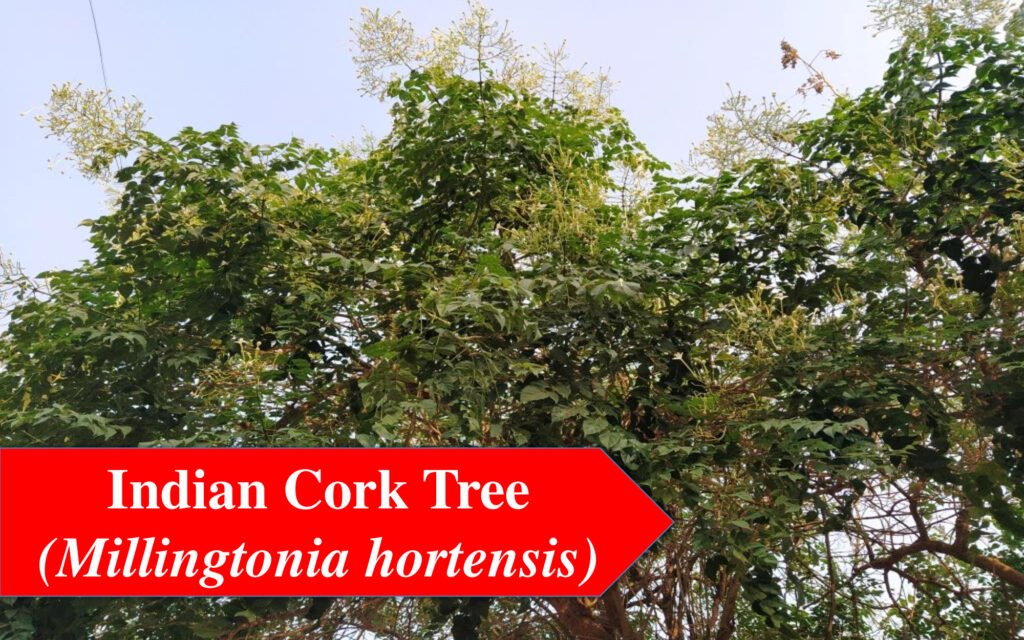
Pride of India (Lagerstroemia speciosa)
The Pride of India, scientifically known as Lagerstroemia speciosa, is a magnificent and esteemed flowering tree that is native to South Asia, particularly India. Also known as the Queen’s Crape Myrtle or Jarul, it is celebrated for its stunning display of colorful flowers, which create an enchanting floral spectacle. It is a large, deciduous tree that can reach upto a height of 15 to 20 metres and suitable for growing in hilly, warm and humid regions with deep moist soil. Lagerstromia strives well in waterlogged soils also.
One of the most striking features of the Pride of India tree is its abundant and showy flowers. During the blooming season, which typically occurs in April to June, the flowers grow on trees in India just like large, terminal clusters of crepe-like blossoms. The flowers come in a variety of colors, including shades of pink, purple, and white, depending on the cultivar. The crepe-like texture of the flowers adds to their appeal, creating an alluring visual display.

Yellow silk cotton tree (Cochlospermum religiosum)
The Yellow Silk Cotton Tree, scientifically known as Cochlospermum religiosum, is a stunning and unique flowering tree native to the Indian subcontinent and other parts of Southeast Asia. Also known as the Golden Silk-Cotton Tree or Buttercup Tree, it is celebrated for its bright yellow flowers that resemble golden silk, creating a captivating spectacle when in full bloom. Yellow silk cotton tree is a deciduous tree that can reach a height of 6 to 10 metres.
One of the most captivating features of the Yellow Silk Cotton Tree is its profusion of large and showy brilliant yellow flowers. During the peak blooming season, which typically occurs in February to March, the tree produces striking cup-shaped blossoms that are 6 to 8 cm in diameter and range in color from bright yellow to deep golden hues. The flowers grow in clusters, adorning the tree with a breath-taking display of golden blooms. The fruits are kidney shaped containing hard seeds that are attached with pure white silky floss.
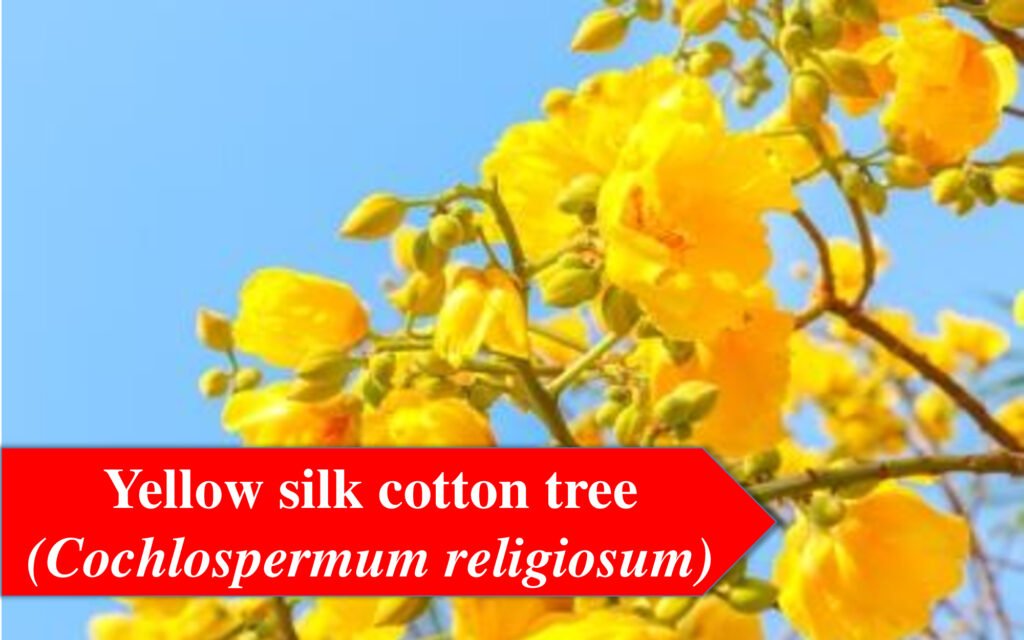
Copper Pod Tree (Peltophorum pterocarpum)
The Copper Pod tree, another famous flower tree in India, scientifically known as Peltophorum pterocarpum, is a magnificent and striking flowering tree that is native to South Asia and parts of Southeast Asia. Also known as the Yellow Flame Tree or the Yellow Gulmohar, it is celebrated for its vibrant and fiery display of yellow flowers that cover the tree in a blaze of color. Copper pod tree is a quick growing, evergreen tree, suitable for growing along with gulmohar, that forms a contrast with its scarlet flowers to the yellow copper pod flowers.
One of the most captivating features of the Copper Pod tree is its profusion of stunning yellow flowers. During the months of February to May and September to November, the tree produces large clusters of trumpet-shaped blossoms. The flowers are a radiant shade of yellow, with splashes of orange and red at the base, creating a breath-taking display that resembles a vivid copper flame. It is suitable for growing as a shade giving tree in avenues and home gardens.
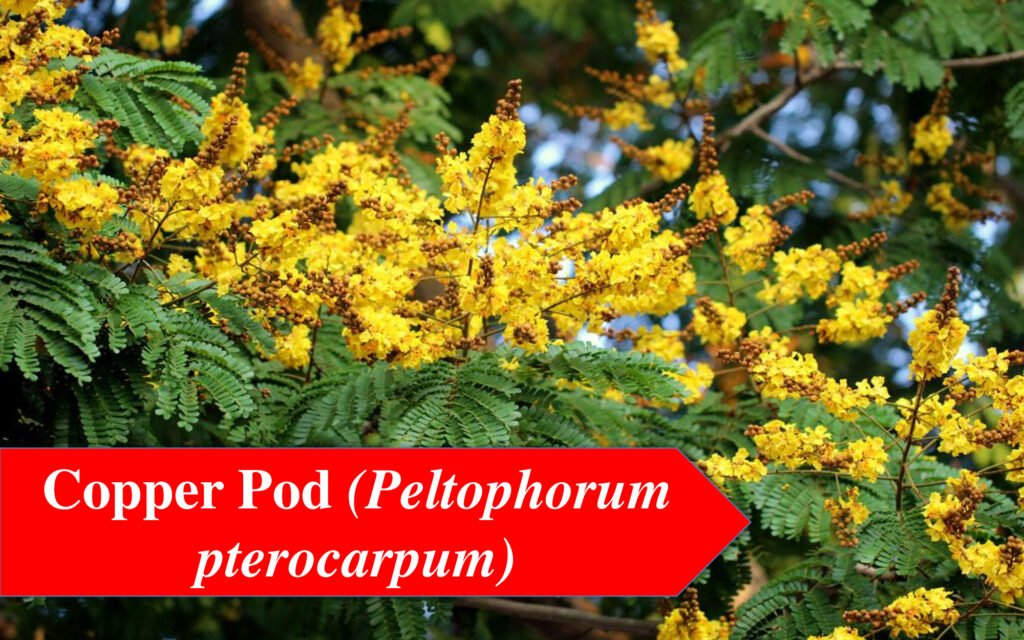
Parijat (Nyctanthes arbor-tristis)
The Parijat tree, scientifically known as Nyctanthes arbor-tristis, is a charming and revered flowering tree that holds significant cultural and religious importance in South Asia, particularly in India. Also known as the Coral jasmine or Night-flowering Jasmine or the Tree of Sorrow, it is celebrated for its delicate and highly fragrant white flowers that bloom at night, releasing a sweet and captivating aroma. The deciduous tree grows only upto 4 metres tall and it is a popularly grown in tropical and subtropical regions of India.
One of the most enchanting features of the Parijat tree is its night-blooming flowers. During the months of September to November, the tree produces clusters of small, star-shaped flowers that are pure white in color with a contrast orange red tubular calyx. These exquisite blooms open at night, filling the air with their heavenly fragrance, and by morning, they gracefully carpet the ground beneath the tree, creating a scene of ethereal beauty. The tubular calyx of the flowers are also used as a substitute for saffron.

Silk Cotton Tree (Bombax ceiba)
The Silk Cotton Tree, scientifically known as Bombax ceiba, is a majestic and iconic tree that belongs to the Malvaceae family. Also known as the Kapok Tree or Ceiba Tree, it is renowned for its quick growing, towering height, large trunk, and fluffy white fibers that surround its seeds. After hearing this feature, don’t you think these are the best garden trees in India which can allure the beauty!!!!!
One of the distinctive features of the Silk Cotton Tree is its flowers. The clustered flowers are borne on leafless branches. The tree produces large, showy flowers that are typically creamy white, pale pink, or yellow. These bell-shaped flowers have prominent stamens and emit a delightful fragrance, attracting various pollinators such as bees and butterflies. The flowering period of the Silk Cotton Tree occurs during the dry season (December to March).
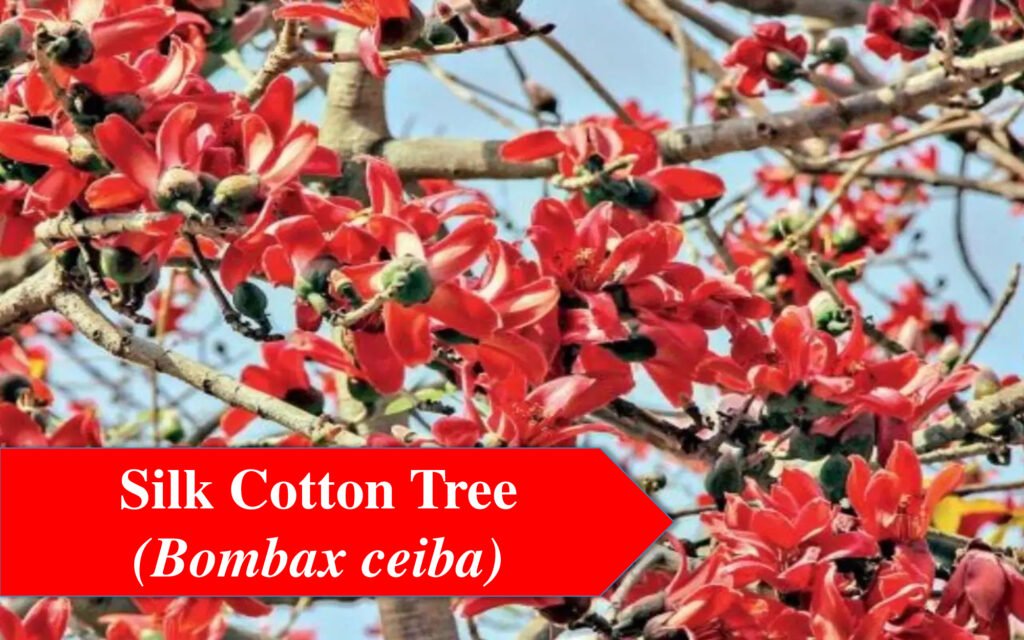
Indian Beech Tree (Pongamia pinnata)
The Indian Beech Tree, scientifically known as Pongamia pinnata, is a versatile and valuable tree native to India and other parts of Southeast Asia. Also referred to as the Pongam Tree or Karanj, it is highly esteemed for its ecological, medicinal, and economic significance.
The Indian Beech Tree is a medium-sized, evergreen tree that can reach heights of up to 15 to 25 meters (49 to 82 feet). It has a dense, spreading crown with a rounded or vase-shaped canopy. The tree features compound leaves with numerous small leaflets that are dark green and glossy, providing an attractive foliage display. It is suitable for growing as shade giving tree, even in small gardens.
One of the notable features of the Indian Beech Tree is its flowers. The tree produces clusters of fragrant, pea-like flowers during April to May that vary in color, including white, pink, or purple. The blossoms are rich in nectar and attract bees and other pollinators, hence the name “Beech Tree.” These flowers are followed by seed pods that contain oil-rich seeds.
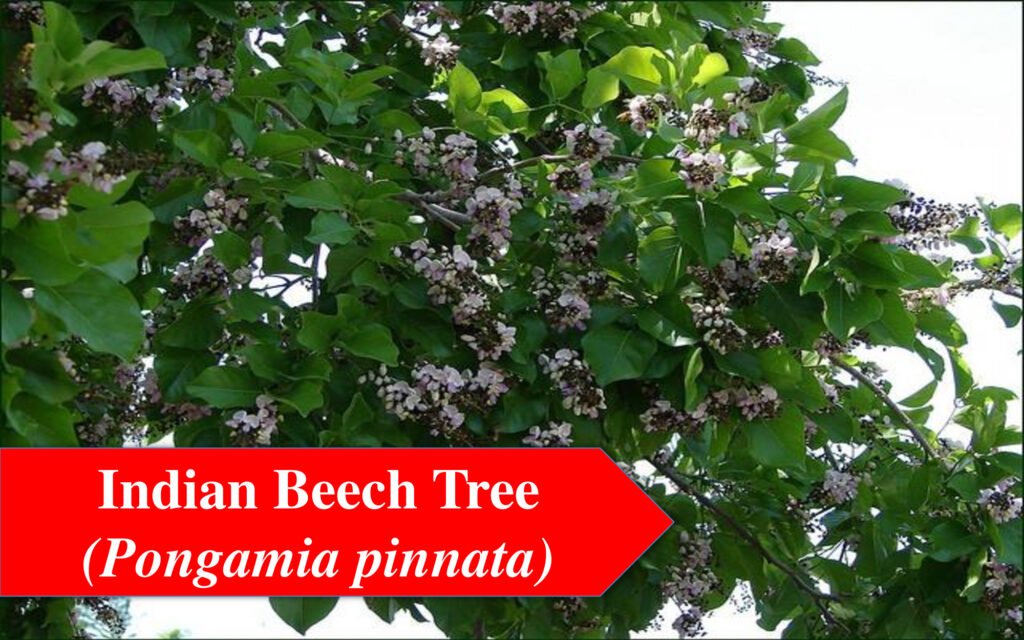
Read More:
Devil’s Tree (Alstonia scholaris)
The Devil’s Tree, also known as Alstonia scholaris, is a tall (15 to 30 metres), evergreen tree with a notorious reputation due to its association with legends and myths. This tree is native to various regions in Asia, including India and Southeast Asia.
One of the notable characteristics of the Devil’s Tree is its distinctive bark and clustered flowers. The bark is grayish-brown in color and has a rough texture with shallow furrows and irregular patterns. Legend has it that the tree’s bark emits an eerie red glow during nighttime, contributing to its ominous reputation. The flowers are greenish yellow in colour that blooms year around. It also emits strong fragrance during night. It is suitable for growing as a shade tree and requires less care and attention.
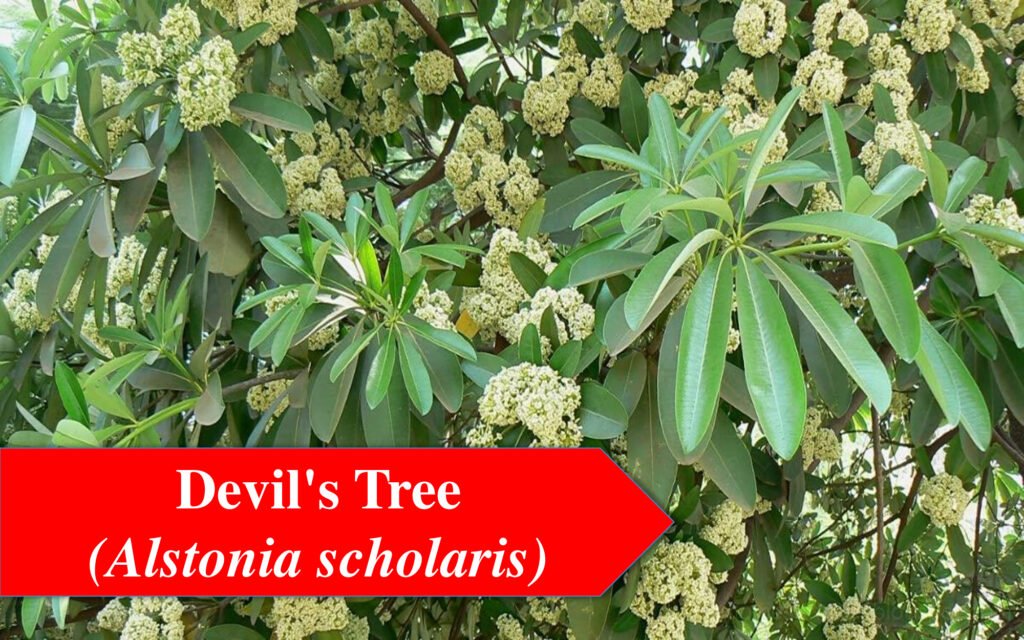
Purple Bauhinia (Bauhinia purpurea)
The Purple Bauhinia, scientifically known as Bauhinia purpurea, is a stunning flowering tree native to South Asia. It is a quick growing, deciduous, moisture loving tree. Also referred to as the Orchid Tree or Butterfly Tree, it is renowned for its unique butterfly-shaped leaves and vibrant purple flowers that bloom during September to December.
One of the distinguishing features of the Purple Bauhinia is its unique leaves. The leaves are deeply lobed, resembling butterfly wings or a pair of ears. They are typically green and glossy, creating an interesting foliage display even when the tree is not in bloom.
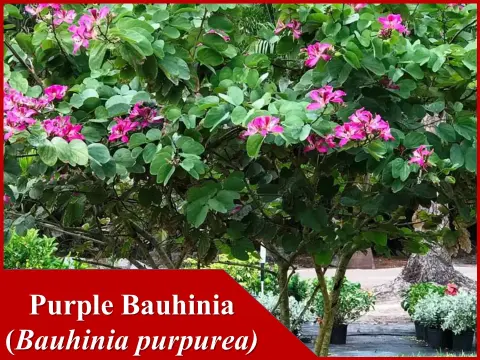
Indian Almond (Terminalia catappa)
The Indian Almond, scientifically known as Terminalia catappa, is a magnificent tree native to the Indian subcontinent and other parts of Southeast Asia. Also referred to as the Tropical Almond, Sea Almond, or Badam tree, it is highly valued for its ornamental beauty, as well as its culinary and medicinal uses. It is a tall, deciduous tree that can thrive well in humid areas. It is suitable for growing in home gardens and in avenues.
The foliage of this tree indicates seasonal changes by attaining a reddish tint during the autumn season. The Indian Almond tree also produces small, inconspicuous flowers that are often white or cream in color and have a pleasant fragrance. One of the most different and unique features of the Indian Almond is its fruit, which resembles a small, woody drupe. The fruit contains a single seed surrounded by a hard shell that resembles an almond. These seeds are edible and highly prized for their nutritional value.
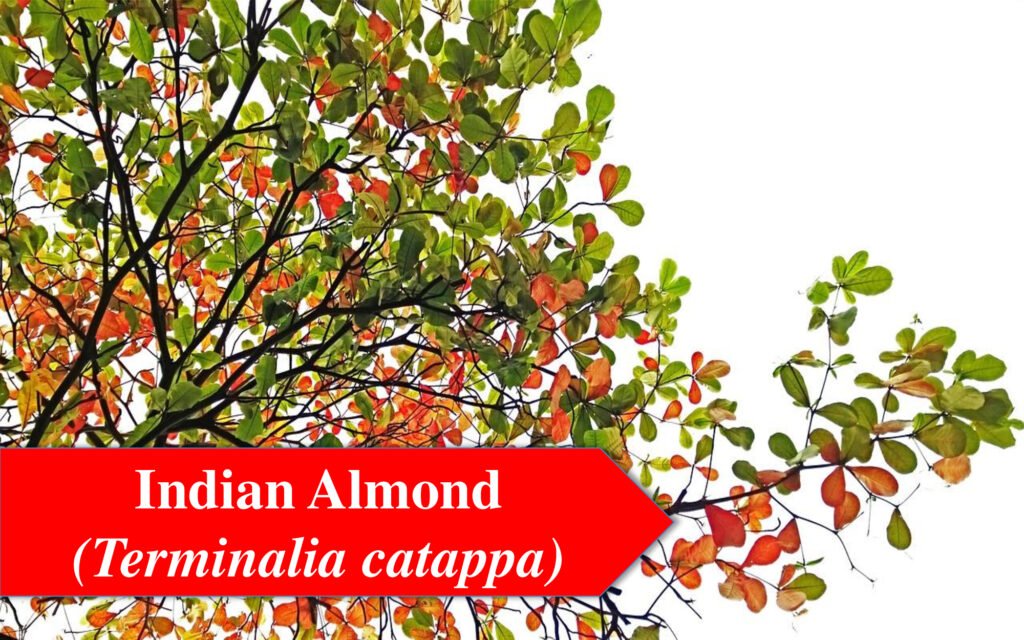
Can I forget these Indian flowering trees? Check the more few more Flowering Trees in India.
Bottlebrush Tree (Callistemon citrinus)
The Bottlebrush Tree, scientifically known as Callistemon, is a unique and striking evergreen, tall-growing tree that belongs to the Myrtaceae family. Native to Australia, the Bottlebrush Tree gets its name from its distinctive flower spikes that resemble the shape of a bottlebrush.
The Bottlebrush Tree is known for its eye-catching flowers, which are produced in dense cylindrical spikes that resemble a bottlebrush, hence its common name. The flowers are typically red, but they can also be found in shades of pink, yellow, or white. These vibrant flower spikes are composed of numerous individual flowers, each with long stamens that give them their brush-like appearance.
In addition to its striking flowers, the Bottlebrush Tree has narrow, lance-shaped leaves that are dark green and glossy. The leaves are arranged in an alternating pattern along the branches, creating an attractive foliage backdrop for the flowers. Some species of Bottlebrush Trees also produce small, woody capsules that contain the tree’s seeds.

Indian Crepe Jasmine (Tabernaemontana divaricata)
Indian Crepe Jasmine, scientifically known as Tabernaemontana divaricata, is a beautiful and fragrant flowering shrub native to India and other parts of Southeast Asia. Also known as Tagar or Nandini, the Indian Crepe Jasmine is treasured for its elegant white blossoms and sweet fragrance.
The Indian Crepe Jasmine is a compact evergreen shrub that typically reaches a height of 2 to 3 feet (0.6 to 0.9 meters) and spreads outwards to a similar width. It has opposite, glossy, dark green leaves that create an attractive backdrop for its flowers. The flowers of the Indian Crepe Jasmine are star-shaped, with five overlapping petals that are pure white in color. The blooms are often borne in clusters and have a delightful, intoxicating fragrance that fills the air.
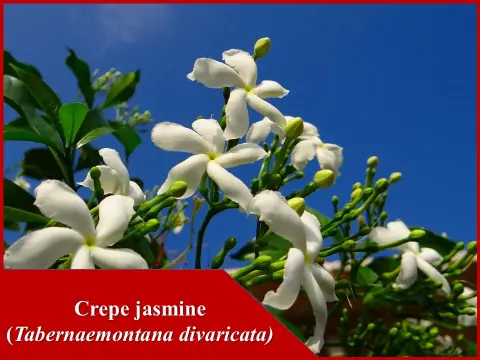
Java Cassia (Cassia javanica)
Java Cassia, scientifically known as Cassia javanica, is a beautiful flowering tree that belongs to the Fabaceae family. Native to Southeast Asia, including Java, hence its common name, Java Cassia is renowned for its stunning clusters of vibrant, fragrant flowers.
One of the most distinctive features of Java Cassia is its flowers. The tree produces abundant clusters of showy, fragrant flowers during flowering season (May to June) that vary in color, ranging from pink, white, and purple to a combination of these hues. The flowers have prominent stamens and exude a sweet, pleasant fragrance, attracting butterflies and bees. The blooms are followed by slender seed pods that contain small seeds.
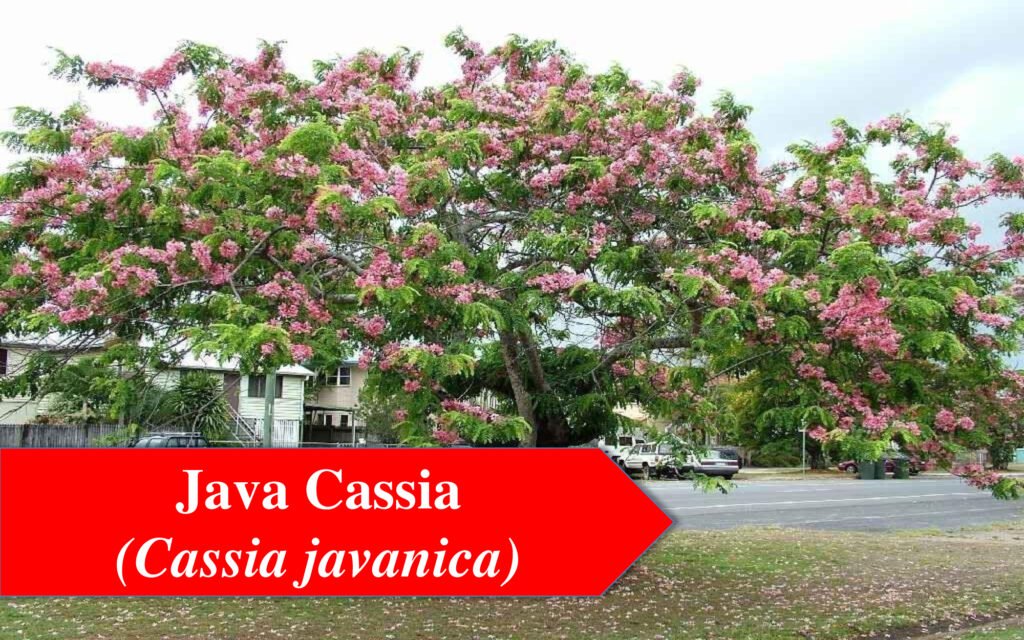
Ruffled palm tree ( Licuala grandis)
Ruffled palm tree, scientifically known as Licuala grandis, is an exquisite palm tree that is native to the rainforests of Vanuatu and the Solomon Islands. Its unique name is derived from the shape and appearance of its large, round leaves, which resemble coconuts and have a distinctive fan-like structure.
Ruffled palm tree, is a slow-growing flowering palm tree that typically reaches a height of 6 to 10 feet (1.8 to 3 meters) in cultivation, but can grow even taller in its natural habitat. Its most striking feature is its large, circular leaves that can span up to 2 feet (60 centimeters) in diameter. The leaves are deeply divided into numerous segments, resembling the shape of an open hand fan. The vibrant green color of the foliage adds a touch of tropical elegance to any indoor or outdoor space. The flowers result in ornamental fruits, that are in striking contrast with the palm leaves, thus ensuring a delightful appearance.
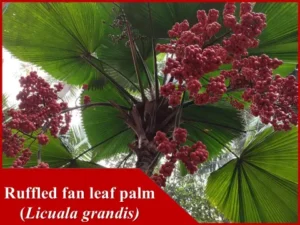
Read More:
- Amazing 10 Indoor Flowering Plants in INDIA
- 16 Amazing Plants For Study Table that Boost Productivity
NO IDEA of setting up a flowering plant? Worry not, have a look at this video!
Taking care of flowers that grow on trees in India requires a combination of knowledge, dedication, and attentiveness. By choosing the right plants, providing adequate sunlight and water, fertilizing appropriately, and practicing regular pruning and pest management, you can ensure the healthy growth and vibrant blooms of your plants. Remember to monitor your plants closely and adapt your care routine based on their individual needs. With proper care, your flowering plants will flourish and bring joy to your garden or indoor space.
Happy gardening!
This article was reviewed by Priyatharsini Ayyaswamy.

Latest Post …..
- Study Agriculture Abroad : A Complete Guide for USA
- July Issue (2024): Times of Agriculture Magazine
- Why Money Plant is called Money Plant ? Answer in 5 min
- How to grow Monstera from Cutting: 5-Step Detailed Guide
- Latest 10 Finest Terrace Garden Ideas to Transform Your Rooftops
- Top 10 Low Light Hanging Plants to make your Room Crunchy
- Best Water Harvesting Techniques for a Sustainable Future
- Low Maintenance Indoor Plants for India: 15 Best plants for home gardening
- Top 23 Flowering Trees in India: Flower Tree for Home











